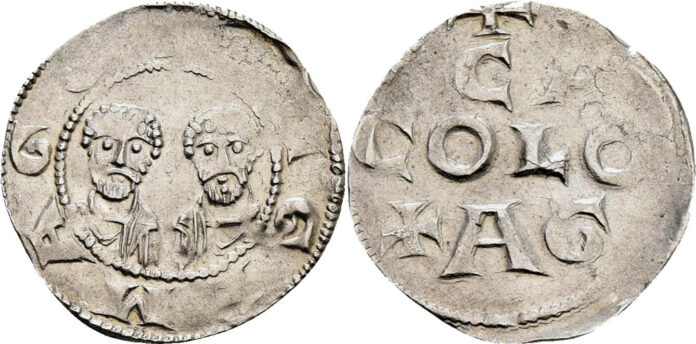Henry III celebrated his 30th birthday in Goslar: on 28 October 1047, he founded a collegiate church there, dedicated to St. Simon and St. Jude. Goslar was also the birthplace of a coinage reform, which immediately catches the eye of today’s observer. From then on, coins featured the frontal portrait of the ruler wearing a crown without arches (Goslar type) or a hoop crown (Dortmund/Duisburg type). This new coin design was soon imitated in various places throughout the central German area such as Halberstadt, Hildesheim, Erfurt or Arnstadt. However, during the Ottonian-Salian period, coins featuring ruler portraits were not yet common; it was not until the reign of Henry II (1002-1024) that they were used more often and they were only established in the royal mints under the rule of aforementioned Henry III (1039-1056). The image of the ruler – whether it be a profile portrait or frontal portrait – was no true-to-life depiction but rather the image of a topos. It showed the qualities and attributes expected of a king: a crown and (often) a beard as well as a sceptre or a lance. It cannot always be determined clearly where the anonymous medallists got the inspiration for their coin designs from. Back then, paintings in churches often were the only images accessible to the public. Thus, they probably played an important role in this context.
Besides their actual monetary function, coins have always been media vehicles and thus historical products of artistic creation and artistic taste. Regarding the 10th/11th century, they even are by far the most extensive group of historical sources conveying the Ottonian-Salian imagery. In contrast, surviving testimonies from the field of book illustration, which are often much better-known than coins from the period, are far less extensive and were only accessible to a selected group of people. Although only very few contemporaries were able to read the inscriptions on the coins, they knew nevertheless how to interpret the visual messages of the issues. At first, these depictions were mainly Carolingian coin images, for example a column temple (a very stylised church inspired by ancient buildings), which were used by East Franconian mints.
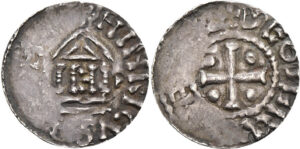
However, it did not take long for the major mints of the empire to create independent coin designs, which were then used by mints of the surrounding areas. An outstanding example for this phenomenon is the Cologne type featuring the name of the city over three lines S / COLONI / A (Sancta Colonia Agrippina), which was minted during the entire Ottonian period and imitated by many other mints.
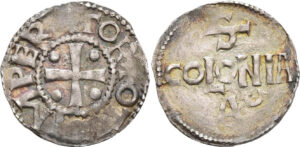
In Remagen, they even produced a coin type that combined the name of the city of Cologne over three lines with the aforementioned saints St. Simon and St. Jude; only their names S SIMON S IVDAS featuring on the Goslar issues were replaced by the Remagen mint with the city’s name in the form of RIGEMAGO.
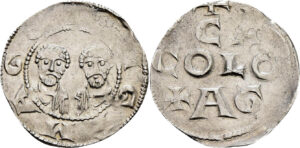
Anyway, images of saints were popular motifs on the coins of many ecclesiastical mints. On the one hand, they implored the institution’s heavenly patron saint and, on the other hand, they could even still be used after the death of the person who held the office (abbot or bishop).
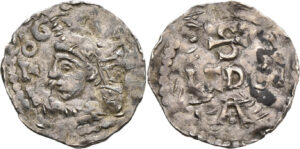
Image traditions also developed regarding the portraits of bishops, regularly depicting the clergyman with chasuble, crosier and book.
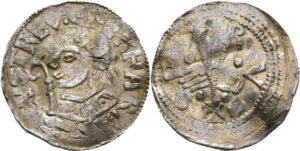
The mitre, on the other hand, can only be found as episcopal headgear on coins minted from about 1100 onwards.
Especially during the Salian rule (1024-1125), the coinage imagery became increasingly diverse. Again, a type was created in Cologne placing the name of the acting archbishop inside a church and combining it with the portrait of the king.
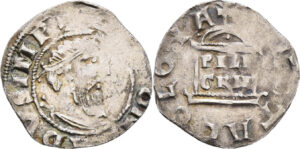
In the second half of the 11th century, the depiction of architectural elements became more elaborate, too. The simple column temples developed into buildings that usually had three towers, were encircled by a city wall and may well be interpreted as symbols representing the city (Lat.: civitas). Circumscriptions such as IMAGO SANCTAE COLONIE (“the image of sacred Cologne”) can probably also be interpreted in this way.
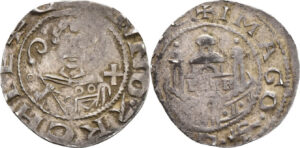
The towns of the Ottonian-Salian empire were not yet self-governing municipalities as they were to be in the late Middle Ages, instead, they were subject to a secular or ecclesiastical ruler of the city, who was also depicted on coins. The name of the city featured in the cross may well be considered a sophisticated combination of script and image. We can see this motif in a variety of forms on coins minted in Duisburg and by many other mints, too.
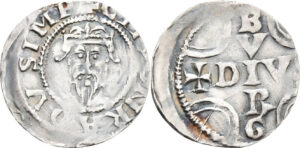
In terms of quantity, coins are the most frequently occurring original source from the Ottonian-Salian empire. Their images and inscriptions convey numerous pieces of information about the life and the faith of their contemporaries. However, in contrast to ancient coins, hardly any research has been carried out on medieval issues as art historical media. This is all the more incomprehensible when presented in such a condensed form as it is the case regarding the numerous objects from the Klaus Giesen Collection, which will now be auctioned off in two parts at Frankfurter Münzhandlung. Apart from the special collection of Dr. Bernhard Schulte (Auktion Münzen und Medaillen GmbH 28, 30/31 October 2008), this is one of the most extensive collections of this kind in recent decades. Thus, the catalogue does not only present the vast variety of coin images of the 10th and 11th century in large-format pictures, but is also a valuable addition to introductory works on the coinage of this time period.
Klaus Giesen (born in 1934) started collecting coins at a relatively late age: he only started to systematically build up his collection when he retired in 1999. He spent most of his working life at a chemical company in the Diepholz district. There, his interest in regional history developed into an interest in late medieval Diepholz coins, and he collected a lot of material and literature on this subject. The results of his numismatic research were included in his catalogue “Die Münzen von Diepholz” (2001), which was soon followed by the no less extensive publication “Die Münzen von Hoya” (2004). To this day, they are standard reference works for coin collectors of these fields and, in 2013, Klaus Giesen was awarded the Eligius Prize of the Deutsche Numismatische Gesellschaft (DNG – German Numismatic Society) for these books.
However, his interest in Ottonian-Salian coins was aroused much earlier. In 1978, Klaus Giesen bought the first coin (No. 307) from this period from a coin dealer in Osnabrück. At first, however, because of his job there was no time to deal with those pieces in more detail for a long time. Only about 20 years later he had the time to deepen his interest in Ottonian-Salian coins and to build up the collection we have today. He did not only purchase the pieces, but used them as starting points for far-reaching historical and numismatic research: between 2012 and 2019, he wrote numerous articles, including his studies on the so-called “Hälblinge” (obols) of “Otto Adelheid pfennigs”, the “EILHARD” denarii and the Remagen mint in the 11th century, which attracted considerable attention among specialists. When asked about his “favourite coin”, Klaus Giesen likes to mention the issues of the Duisburg mint, his birthplace.
However, the promotion of young numismatists has also always been very close to his heart. In December 2019, he donated a collection of almost 800 world coins to the grammar school in Damme for teaching purposes. He had collected the pieces during professional and private trips and added about 130 German coins, by means of which the patchwork of coinage prior to the foundation of the empire in 1871 can be explained to pupils in a particularly vivid way. But he was also a welcome guest in many university courses, providing students with literature recommendations and copies of essays and even bringing pieces from his collection to class as illustrative material.
Moreover, Klaus Giesen is also a sought-after advisor on questions about medieval Westphalian coinage. He became member of the association “Münzfreunde für Westfalen und Nachbargebiete” (Coin lovers for Westphalia and neighbouring areas) through the acquaintance with Peter Ilisch, whom he contacted for the first time at the end of the 1990s regarding the copy of an essay. To this day, he is a permanent member of the “Münzbolde”, who meet on a regular basis. This might be one of the reasons why, in recent years, he has repeatedly been interested in the biographies of well-known collectors.
Klaus Giesen believes that coins can often tell us more than written sources, of which only a few dating from the early and high Middle Ages have survived. Furthermore, being “tangible history”, original objects still exert the greatest fascination among people interested in history. Proof of this statement is now available in the form of the auction catalogue of the Giesen Collection, and the pieces it contains will hopefully inspire many readers to explore the Middle Ages and the coinage of this period.
All lots of this auction can be found in the online auction catalogue.
In a German CoinsWeekly article, we discussed an anthology including an article by Klaus Giesen: Westfalia Numismatica 2013.
For further information about the Frankfurter Münzhandlung, please visit the website of this auction house.
The auction house of long-standing tradition was reopened last year, here you can find the corresponding CoinsWeekly article.




